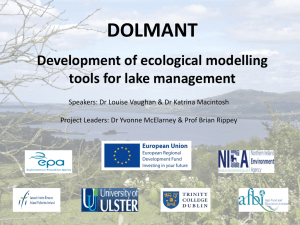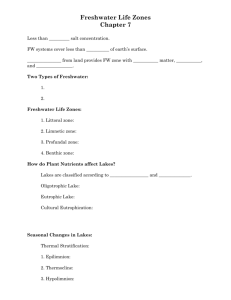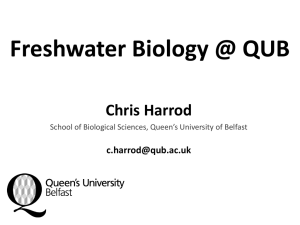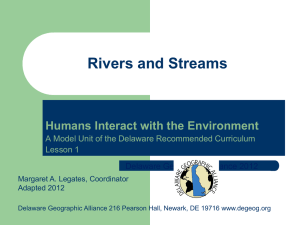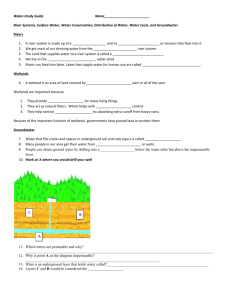5.9. Rivers & Streams Habitat Action Plan
advertisement
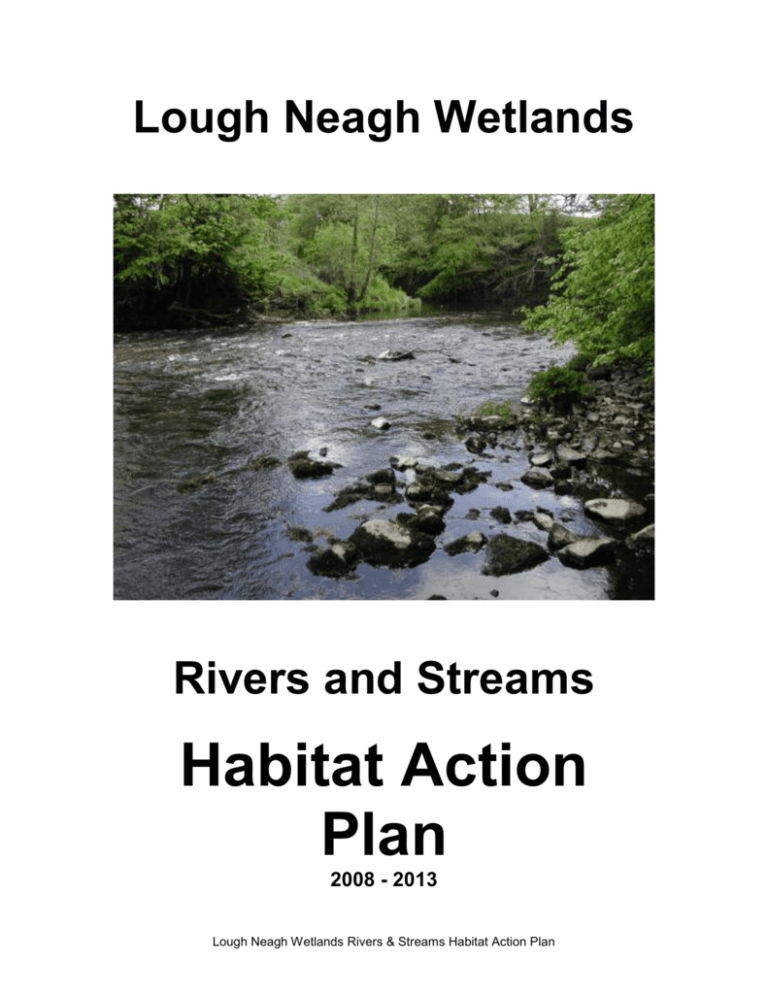
Lough Neagh Wetlands Rivers and Streams Habitat Action Plan 2008 - 2013 Lough Neagh Wetlands Rivers & Streams Habitat Action Plan Rivers and Streams in the Lough Neagh Wetlands Introduction Six major rivers flow into Lough Neagh, and one river drains the Lough into the sea. The Moyola River enters the Lough along the north-west shore at Ballymaguigan; the Ballinderry River enters the Lough along the western shore north of Ardboe; the River Blackwater enters the Lough at Maghery; the Upper Bann enters the Lough at Charlestown along the southern shore; the Six Mile Water enters the Lough near Antrim Town and the River Main enters the Lough near Randalstown. The Lower Bann then drains Lough Neagh from Toome towards the sea. The Clady River joins the Lower Bann about 15km north of Toome. There are several smaller rivers and streams also flowing into Lough Neagh, including the Crumlin River and the Glenavy River. About 43% of Northern Ireland, plus a small area of the Republic of Ireland, drain into Lough Neagh via its inflowing rivers and streams. The total area of land that is drained into the Lough via these rivers and streams is about 4,453 square km. With a complex underlying geology, these rivers and streams provide a rich diversity of habitats which support a large number of ecologically important species, some of which are rare and considered to be vulnerable or endangered. The most important of these species are listed in the next section, with a brief description of their basic habitat requirements. Background FISH Atlantic Salmon & Brown Trout All the major rivers, and many of the smaller tributaries within the Lough Neagh Wetlands, contain populations of Atlantic salmon, river brown trout and dollaghan trout. These rivers are designated as Salmonid Rivers in accordance with the EU Fish Directive and support valuable recreational and commercial fisheries for these species. Atlantic salmon migrate from the Atlantic Ocean, up the Lower River Bann and into Lough Neagh. This migration can take place during any month of the year but is particularly pronounced in late summer and early autumn. Those fish which enter the river early tend to spend long periods resting in deep pools and the migration to the spawning grounds may take several months. Fish rarely move Lough Neagh Wetlands Rivers & Streams Habitat Action Plan when the river is low and most migration takes place on a rising or falling flood. They continue up the rivers to spawn in the gravely areas of their tributary streams from late November through to mid February. Eggs (ova) are laid in the gravel beds in depressions excavated by the females, known as ‘redds’. Once fertilised, the ova are buried under gravel and remain there until they hatch in late March or early April. The newly hatched fish, known as alevins, spend the next four or five weeks in the gravel before finally emerging as fry. Juveniles then move from the spawning areas and take up residence in “nursery areas”, stoney sections of the stream which provide them with food, cover and protection from predators- and where they actively defend territories from other salmon. The fry grow in these nursery areas for one or two years until they become large enough to migrate to sea. At this stage they become silvery and are known as “smolts”. The seaward migration is stimulated by water temperature and takes place in the spring, March to May. The fish grow rapidly in the sea for one or two years and return as adults to the river of their birth to complete their life cycle. River brown trout & dollaghan brown trout are found in the tributary streams and rivers of Lough Neagh, and are a migratory fish following a similar life cycle, habitat requirements and migration pattern as salmon, but most individuals remain in freshwater all their lives. River brown trout stay in the river all their lives but migrate up and down stream. The Lough Neagh catchment supports a distinctive variety of brown trout known as “dollaghan”. Like salmon, adult dollaghan migrate from the Lough into the feeder rivers during late summer and autumn. They will use even the smallest of streams where the gravel substrate is suitable and the water is clean. Spawning takes place earlier than salmon (October to December) and the fry hatch earlier in the springtime (February to March). The juvenile trout spends two to three years in the stream before migrating downstream to the Lough where it feeds for another two years or so before returning to the rivers to spawn. The most important components of the habitat for both salmon and trout are: A plentiful, year round supply of clean well aerated, fast flowing water; Abundance of clean spawning gravel 30 to 80mm diameter; Good bed cover with stones and boulders up to 500mm diameter; Natural overhanging banks providing cover and supporting native vegetation; Deep pools Freedom from obstacles limiting migration. The European eel The eel breeds at sea and has its growing phase in fresh water. Eels frequent every Lough Neagh tributary. They are thought to breed in the South West Atlantic Ocean in the region of the Sargasso Sea. The larval eel (known as Leptocephali) cross the ocean from west to east, before entering European waters and metamorphosing into transparent glass eels. Most glass eels continue their migration into estuaries and then into fresh water. At this stage, the Lough Neagh Wetlands Rivers & Streams Habitat Action Plan glass eels change again, actively swimming upstream, darkening as pigmentation develops and are known as elvers. Eels are long lived and some females may stay in fresh water for up to 50 years although 10 to 15 years is more common. After the growing stage, the eel undergoes another change and migrates seawards, develops maturing gonads and returns to the Sargasso Sea where it is presumed that spawning takes place. The eel is fished commercially in Lough Neagh where one of the largest eel fisheries in Europe exists, making it a very important natural resource for the local people. River Lamprey River lamprey live in Lough Neagh and in the inflowing rivers. They are migratory, growing to maturity in estuaries before moving into freshwater to spawn in clean rivers and streams. The larva spend several years in silt beds before metamorphosing and migrating downstream to the estuary. It is thought that those found in Lough Neagh do not migrate to the estuary, preferring instead to stay in Lough Neagh to feed and migrate up the rivers to spawn. It has been discovered that they exist in the Lough all year round and research is currently ongoing to confirm if indeed they remain in the Lough without ever migrating to sea. With a very strong chance that this is the case, the Lough Neagh population would be one of only two found in the UK where this occurs, Lough Lomond in Scotland being the other. Adult fish feed by attaching themselves to fish of other species and often inflict extensive damage by rasping away large amounts of flesh from the back. In Lough Neagh lampreys are often found attached to pollan and trout. The river lamprey has declined in Britain over the last hundred years and is now given some protection as a species of community interest under the EU Habitats Directive and in the UK Biodiversity action plan. Habitat requirements include; Suitable estuarine conditions, free from pollution, with suitable prey fish species. A clear migration route to the spawning grounds, with suitable river flows and no barriers. A stony, gravely substrate to spawn and to hide. After hatching, slower flowing nursery areas of sandy silt in fresh water above the estuary. Brook Lamprey Brook lamprey are common in the tributaries of Lough Neagh and the Lower River Bann. They never migrate to sea and their spawning and juvenile habits are similar to the river lamprey. Pollan. Lough Neagh Wetlands Rivers & Streams Habitat Action Plan The pollan is one of a handful of freshwater fish native to Ireland. Their limited distribution suggests that they may have been the first species to colonise freshwater in Ireland at the end of the last Ice age. In Lough Neagh, adult pollan mature at two to three years old and spawn on gravels on the Lough bed. The ova hatch after two months or so, depending on the water temperature and the resulting fry feed on zooplankton within the water column. Lough Neagh contains a healthy population of pollan and supports a fishery where the fish are sold locally and exported as food and bait fish. Populations have declined elsewhere in Ireland and the species is listed for protection under the EU Habitats direction. Other fish Other fish reported from the rivers and streams of the Lough Neagh Wetlands, include, sea lamprey, stoneloach, minnow, three-spined stickle-back, nine-spined stickle-back, pike, gudgeon, roach, rudd, perch, tench and bream. BIRDS Kingfisher Kingfisher frequents all the rivers and streams in the Lough Neagh Wetlands. The populations in Britain and Ireland are the most important in the whole of Northern Europe. Kingfishers require relatively shallow and slow moving water with thriving populations of small fish on which to feed, and vertical steep river banks of fairly soft material where they can excavate their nesting burrows. Their prey species are very susceptible to water pollution and there may be stretches of river habitat where fish stocks have been reduced or eliminated. The presence of this species is a very good indicator of the quality of rivers and streams. Numbers can crash badly following severe winters but the species is well adapted to make up its numbers again quickly by being able to produce large broods of up to six nestlings, three or four times per year. Recent dry summers have led to declining water quantity in rivers and streams and this could threaten the fish on which kingfishers feed. Low water levels increase the risk of predation at nesting holes normally protected by the water beneath their vertical faces. Dipper The dipper is a truly aquatic bird that breeds along rivers and streams in the Lough Neagh Wetlands, where there are weirs with fast running water, and bridges or over-hanging rocks where they build their nests. Rivers and streams that contain dippers have an abundance of invertebrate larva such as mayfly and caddis flies on which to feed. Dippers start breeding from February and those that nest along neutral waterways can lay larger clutches of eggs than those nesting along acidic waters. There are difficulties for dippers in supporting broods along acidic waters because of low invertebrate abundance, and low calcium availability at these sites. Dippers are therefore indicators of acidity by their absence or scarcity. Lough Neagh Wetlands Rivers & Streams Habitat Action Plan Grey Wagtail Grey wagtails are birds with a preference for feeding along fast flowing rivers and streams that are bordered by broadleaved trees and where there are rocks, riffles and areas of gravel. In the Lough Neagh Wetlands areas such as millraces, weirs and canal locks are among the places sought out by this species. Unlike dippers, the breeding abundance of grey wagtail is little affected by the acidification of water courses because of the wider range of insects that they feed on, which includes aquatic and non aquatic species, hence their preference for trees along rivers and streams. Sand Martin Sand martins are associated with rivers and streams that have steep sandy banks in the Lough Neagh Wetlands. They are summer migrants that begin to return to the Wetlands in March. Numbers that return to breed are dependent upon the conditions they face in their wintering grounds in the Sahel region of Africa, with population crashes having taken place in the past, following severe Sahel droughts. They nest in colonies in sandy river banks where many pairs will rear two broods if the conditions are suitable. They also feed along the waterways, collecting flies in mid air. MAMMALS Otter The otter is a Northern Ireland Priority Species that lives along rivers and streams in the Lough Neagh Wetlands. There has historically been a healthy population of this species in Northern Ireland but recent surveys suggest that we should be vigilant as there has been a slight decrease in signs of otter activity over the last 20 years. Otters are good indicators of water quality in that they need clean, unpolluted water with a large and varied supply of food. Dense, undisturbed areas of bankside vegetation are also essential to provide cover when the animal is resting during the day and for breeding purposes. Otters are shy, solitary animals that are active mainly at night along rivers and streams. They are always found near freshwater — even in coastal areas the otter must have access to freshwater to wash seawater from their coats. Up to four cubs are usually born during the summer months in an underground den or holt and stay with their mothers for about a year. They feed mainly on fish, frogs and whiteclawed crayfish. The actual number of otters present in the Lough Neagh Wetlands is not known. Daubenton’s Bat Daubenton’s Bat, also known as Water Bat because it opportunistically feeds close to water, is thought to be relatively common and fairly widespread in the Lough Neagh Wetlands. It is found on most rivers where it feeds over still water and roosts/hibernates in bridges, stone walls and tree holes. They are at risk Lough Neagh Wetlands Rivers & Streams Habitat Action Plan from tree removal or from stone walls being modified around bridges etc. The species is considered to be common in the Lough Neagh Wetlands, but in Northern Ireland the total number of animals may be only a few hundred. However, Daubenton’s bats are thought to be fairly widespread but not seen very often. It forages typically within 30cm of the surface of the water. Here it either trawls for insects from the surface of the water by gaffing them with its large feet or the tail membrane or takes them directly out of the air (aerial hawking). They can be observed flying continuously back and forth along a river, using a regular flight path. OTHER FAUNA White-clawed Crayfish White-clawed crayfish occur in areas with hard alkaline water and are generally found near undercut or overhanging banks and submerged tree roots and saturated logs. This is a Northern Ireland Priority Species, found in two of the river systems of the Lough Neagh Wetlands - the River Blackwater and the Ballinderry River. Adults can reach up to 12cm in size and the males have bigger claws than females and are more territorial during the breeding season from September to November. They reach maturity and begin to breed at 4 years old. Females spend the winter and early spring with eggs held under their tails, releasing juveniles at the beginning of June. During moulting and the release of juveniles, crayfish are very prone to predation by fish, mammals, birds and even insect larvae. The species is nocturnal, living under rocks and submerged logs or plants during the day, emerging at night to find food. They are omnivorous and their diet includes worms, insect larvae, snails, small fish and macrophytes. Debris like dead leaves that enters water courses can also be important food as crayfish tend to become more vegetarian with age. A major threat to the whiteclawed crayfish is posed by the introduction of non-native species of crayfish, which have been farmed in Britain since the late 1970s but has not yet been found in Ireland. Signal crayfish carry the crayfish plague (a virulent disease caused by a fungus) which can spread rapidly, causing drastic losses of native crayfish in rivers. Crayfish plague can be introduced into a waterbody not only by entry of signal crayfish but also by water, fish or equipment that has been in contact with signals. This greatly increases the risk to remaining white-clawed crayfish populations. Freshwater Pearl Mussel Freshwater pearl mussels are found in the Ballinderry River. However, the species has disappeared from the lower stretches of the Ballinderry River but are still present in the upper reaches. There is no reason why the species should not re-colonise the lower reaches of this. And other rivers in the Lough Neagh Wetlands, if water quality improves. The Ballinderry River Enhancement Associate is undertaking a breeding programme which could help restock these local rivers.. Lough Neagh Wetlands Rivers & Streams Habitat Action Plan Threats Pollution With around 38% of Northern Ireland and a small area of the Republic of Ireland, draining into Lough Neagh via its rivers and streams, there is considerable threat from activities both within and beyond the boundary of the Lough Neagh Wetlands which cause water pollution and habitat/species removal. The quality of the rivers and streams that feed into Lough Neagh cannot be separated from the quality of Lough Neagh and the Lower River Bann. The Lower River Bann is the route for fish migrating into the Lough and therefore the quality of the water reaching Lough Neagh via its inflowing rivers, dictates the quality of the Lower Bann. River Engineering Loss of gravel beds for spawning fish as a result of drainage and run-off, where silts gather, covering gravel beds that form the breeding habitats of salmonid fishes. Such siltation, if extreme, can cover potential spawning areas or can impact spawning success by smothering eggs buried in the gravel. This can also cause the loss of habitat such as shallow, brisk ripples for spawning fish. Development beside rivers and on floodplains River bank erosion caused by unstabalized river banks as a result of tree removal, the presence of livestock and the river bank invasive plant species such as Hymalian balsam, giant hogweed, and rhododendron. For example, species such as rhododendron are very dense and fast growing which shades out light along the riverbed and stops vegetation growing along the riverbank. This causes bank erosion, resulting in silt being washed into the river. Loss of breeding areas and habitat for species such as white-clawed crayfish Loss of bank side vegetation and steep sandy banks, trees and stone walls etc. This affects many species including otter, kingfisher, sandmartin, Daubenton’s bat etc Obstructions to migration Loss of rivers and stream habitat due to culverts being placed to aid development, and the placing of bridge inverts and weirs all prevent fish migration. Water Levels Low water levels in summer and future water abstraction from Lough Neagh Lough Neagh Wetlands Rivers & Streams Habitat Action Plan Opportunities Managing Designated / Undesignated Waterways Where regular maintenance works are carried out to designated watercourses, the rivers/stream should be assessed to determine what work can be undertaken to benefit local biodiversity, and plans developed accordingly with Rivers Agency. Where regular maintenance works are carried out on undesignated water courses the rivers/stream should be assessed to determine what work can be undertaken to benefit local biodiversity, and plans developed with the riparian owners (farmers etc) via Single Farm Payment / Agri-environment schemes. This should include retaining and creating rough grass river margins, re-profiling the banks, creating berms, ensuring fencing is installed to prevent river bank erosion and poaching where cattle drink in streams. It should also include where appropriate, introducing natural flood management schemes such as the creation of floodplain storage areas and wet meadows. Stakeholder Groups for river catchments in the Lough Neagh Wetlands, set up as part of the implementation of the Water Framework Directive should be utilized to develop practical river conservation projects Water Quality Sustainable Drainage Systems and Constructed wetlands should be promoted and used to address the issue of poor water quality and silting in rivers and streams Water pollution including highlighting continuous pollution problems should be reported using the EHS Pollution Hotline Rainwater harvesting should be promoted and used to enhance river water quality and conserve water Where appropriate, buffer zones should be created along rivers and streams to protect water quality and create linear features for species such as tree sparrow and barn owl. This should be complemented with sensitive land management to ensure that undue pressure is not being placed on riparian land and associated drainage infrastructures, It is worth noting that buffer zones may not be the most effective method of reducing diffuse pollution, as fields in the LNW are often too small to take out the buffer area required and still have a viable working field area. Also a history of sub surface drainage means that most pollutants would simply travel below a buffer strip. Better land management is the most effective way to reduce diffuse pollution. Surveys Lough Neagh Wetlands Rivers & Streams Habitat Action Plan Surveys should be conducted along Key Rivers to highlight threats and identify obstructions to fish and other riparian wildlife, and look for opportunities for enhancement, rehabilitation and restoration projects that focus on local and national priority species. Projects should be carried out as a result of river surveys. The use of volunteers in these surveys should be considered. Record the location of invasive species along river banks / and in rivers and streams and target areas for local invasive species action plans Raise Awareness Raise awareness of water quality and of the creation and management of habitats for river and stream biodiversity Non-native fish Control the stocking of non-native fish by using local genetic stock. Best Practice advice Produce best practice advice for farmers and developers Lough Neagh Wetlands Rivers & Streams Habitat Action Plan Lough Neagh Wetlands Rivers & Streams Habitat Action Plan Rivers and Streams - Objectives & Targets Objectives & Targets OBJECTIVE TARGET RV/01 To maintain the extent and quality of River & Stream habitats 2013 RV/02 To Restore river and stream habitats to good ecological status in line with the Water Framework Directive 2013 RV/03 To raise awareness of River and Stream conservation 2013 Lough Neagh Wetlands Rivers & Streams Habitat Action Plan Rivers and Streams - Action Actions ACTION LEAD PARTNER RV/A1 Form 1 Stakeholder Group for the Coppies River catchments in the Lough Neagh Wetlands, in line with the Water Framework Directive / River Basin Management Plan and develop practical river conservation projects through this group LNP RV/A2 Initiate a programme that creates at least one Sustainable Drainage System that addresses the issue of sediment loading in rivers. Use this as a demonstration site and hold 5 workshops (1 workshop each year) to promote the use of these systems and to promote the wise use of water Initiate a programme that creates at least 1 Water Harvesting project to enhance river water quality and conserve water. Use this as a demonstration site and hold 1 workshop each year to promote the use of these systems and to promote the wise use of water LNP Initiate a programme that creates at least one Constructed Wetland that treats water that is being discharged into rivers from septic tanks. Use this as a demonstration site and hold 5 workshops (1 workshop each year) to promote the use of these systems and to promote the wise use of water Survey 1 river per year highlight threats and obstructions to fish and other riparian wildlife, and identify opportunities for enhancement, rehabilitation and restoration projects that focus on local and national priority species. As part of these surveys, map the location of invasive species along river banks and in the rivers/streams in the LNP RV/A3 RV/A4 RV/A5 LNP LNP PARTNERS EHS / LNAC / MDC / Moyola Angling Club / DCAL / DARD / Rivers Agency / QPANI LNAC / EHS / Rivers Agency / Planning Service DARD / QPANI / CBC EHS / LNAC / Northern Ireland Water / Planning Service / QPANI / CBC LNAC / EHS / Planning Service / CBC EHS WMU / DCAL / EHS / Rivers Agency / DARD / BREA / LNAC / CBC Lough Neagh Wetlands Rivers & Streams Habitat Action Plan TO BE ACHIEVED BY 31st Dec: 2008 OBJECTIVES MET RV/02 2008 RV/02 2009 RV/02 / RV/03 2010 RV/02 2013 RV/01 RV/02 RV/A6 Lough Neagh Wetlands and use this to set targets for local invasive species action plans. Carry out 5 significant projects (1 project each year) as a result of river surveys conducted to identify opportunities for enhancement, rehabilitation and restoration projects that focus on local and national priority species. LNP RV/A7 Promote the uptake of volunteer surveys along Rivers & Streams in the Lough Neagh Wetlands. LNP RV/A8 Write 5 articles (1 article per year) to highlight the importance of water quality in rivers and stream for biodiversity, highlight the range of species found in rivers and streams and promote the appropriate management of riparian habitats in the Lough Neagh Wetlands LNAC RV/A9 Raise awareness on an annual basis among agri-environment scheme advisors, and promote the take-up of agri-environment options that benefit rivers and streams in the Lough Neagh Wetlands LNAC RV/A10 Raise awareness on an annual basis among Developers of the damage caused to biodiversity by culverting rivers and streams as part of developments, and inform planners and developers about alternative action that safeguard these habitats LNAC RV/A11 Encourage stakeholders to report water pollution and highlight continuous pollution problems to Statutory Agencies, using the Pollution Hotline EHS EHS / LNAC / Rivers Agency / WWF/BREA / DCAL / DARD / CBC LNAC / RSPB / EHS / CVNI / UWT / WWF/BREA / CBC LNP / DCAL / EHS / DARD / QPANI / Rivers Agency / RSPB / UWT / WWF/BREA / CBC LNP / DCAL / EHS / DARD / FWAG / Rivers Agency / RSPB / UWT / WWF/BREA LNP / DCAL / Planning Service / EHS / Rivers Agency RSPB / UWT / WWF/BREA / CBC LNAC / LNP / WWF/BREA / CBC Lough Neagh Wetlands Rivers & Streams Habitat Action Plan 2013 RV/01 / RV/02 2013 RV/03 2013 RV/03 2013 RV/03 2013 RV/03 2013 RV/01 / RV/02 / RV/03 RV/A12 RV/A13 Ensure that biodiversity issues are taken into account during the planning and implementation of maintenance works on designated watercourses Ensure that all water courses receive adequate management planning and that floodplains are used to retain water for longer periods rather than aiming for instant drainage and water run-off Rivers Agency EHS LANC / DARD / EHS / CBC 2013 RV/01 / RV/02 DARD / LNP / LNAC / CBC 2013 RV/01 / RV/02 Lough Neagh Wetlands Rivers & Streams Habitat Action Plan
